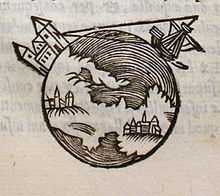De sphaera mundi

De sphaera mundi (Latin title meaning On the Sphere of the World, sometimes rendered The Sphere of the Cosmos; the Latin title is also given as Tractatus de sphaera, Textus de sphaera, or simply De sphaera) is a medieval introduction to the basic elements of astronomy written by Johannes de Sacrobosco (John of Holywood) c. 1230. Based heavily on Ptolemy's Almagest, and drawing additional ideas from Islamic astronomy, it was one of the most influential works of pre-Copernican astronomy in Europe.
Reception
Sacrobosco's De sphaera mundi was the most successful of several competing thirteenth-century textbooks on this topic. It was used in universities for hundreds of years and the manuscript copied many times before the invention of the printing press; hundreds of manuscript copies have survived. The first printed edition appeared in 1472 in Ferrara, and at least 84 editions were printed in the next two hundred years. The work was frequently supplemented with commentaries on the original text. The number of copies and commentaries reflects its importance as a university text.[1]
Content

The universe as a machine
Sacrobosco spoke of the universe as the machina mundi, the machine of the world, suggesting that the reported eclipse of the Sun at the crucifixion of Jesus was a disturbance of the order of that machine. This concept is similar to the clockwork universe analogy that became very popular centuries later, during the Enlightenment.[2]
Spherical Earth
Though principally about the universe, De sphaera contains a clear description of the Earth as a sphere which agrees with widespread opinion in Europe during the higher Middle Ages, in contrast to statements of some 19th- and 20th-century historians that medieval scholars thought the Earth was flat.[3]
References
- ↑ Olaf Pedersen, "In Quest of Sacrobosco", Journal for the History of Astronomy, 16 (1985): 175-221. Pedersen identifies 35 printings in Venice, another 35 in Paris, and more in 14 other cities throughout Europe.
- ↑ John of Sacrobosco, On the Sphere, quoted in Edward Grant, A Source Book in Medieval Science, (Cambridge: Harvard Univ. Pr., 1974), p. 465.
- ↑ Jeffrey Burton Russell, Inventing the Flat Earth (New York: Praeger, 1991): 19, 26–27. ISBN 0-275-93956-1.
Sources
- Pedersen, Olaf. "The Corpus Astronomicum and the Traditions of Medieval Latin Astronomy: A Tentative Interpretation. pp. 59–76 in Owen Gingerich and Jerzy Dobrzycki, eds., Colloquia Copernicana III. Wrocław: Ossolineum, 1975.
- Thorndike, Lynn. The Sphere of Sacrobosco and its Commentators. Chicago: Univ. of Chicago Press, 1949.
External links
-
 Media related to De sphaera mundi at Wikimedia Commons
Media related to De sphaera mundi at Wikimedia Commons - Summary of the contents of each chapter
- Sacrobosco's De Sphaera – complete treatise in English translation
- Book, The Sphere of Sacrobosco and its Commentators, by Lynn Thorndike, year 1949. Text in Latin, English translation, and commentary.
- Treasures of the RAS: The Sphere by John of Hollywood on YouTube
- Selected images from Sphaera mundi From The College of Physicians of Philadelphia Digital Library